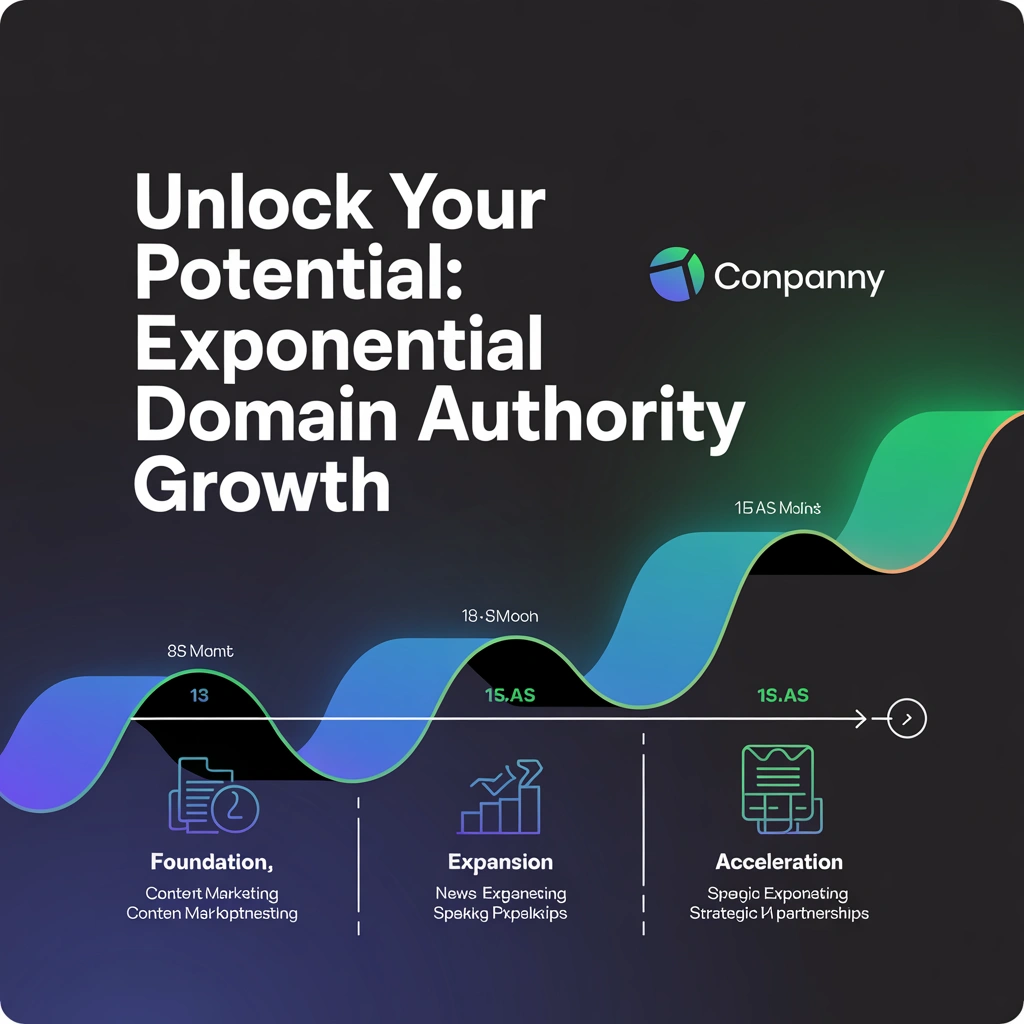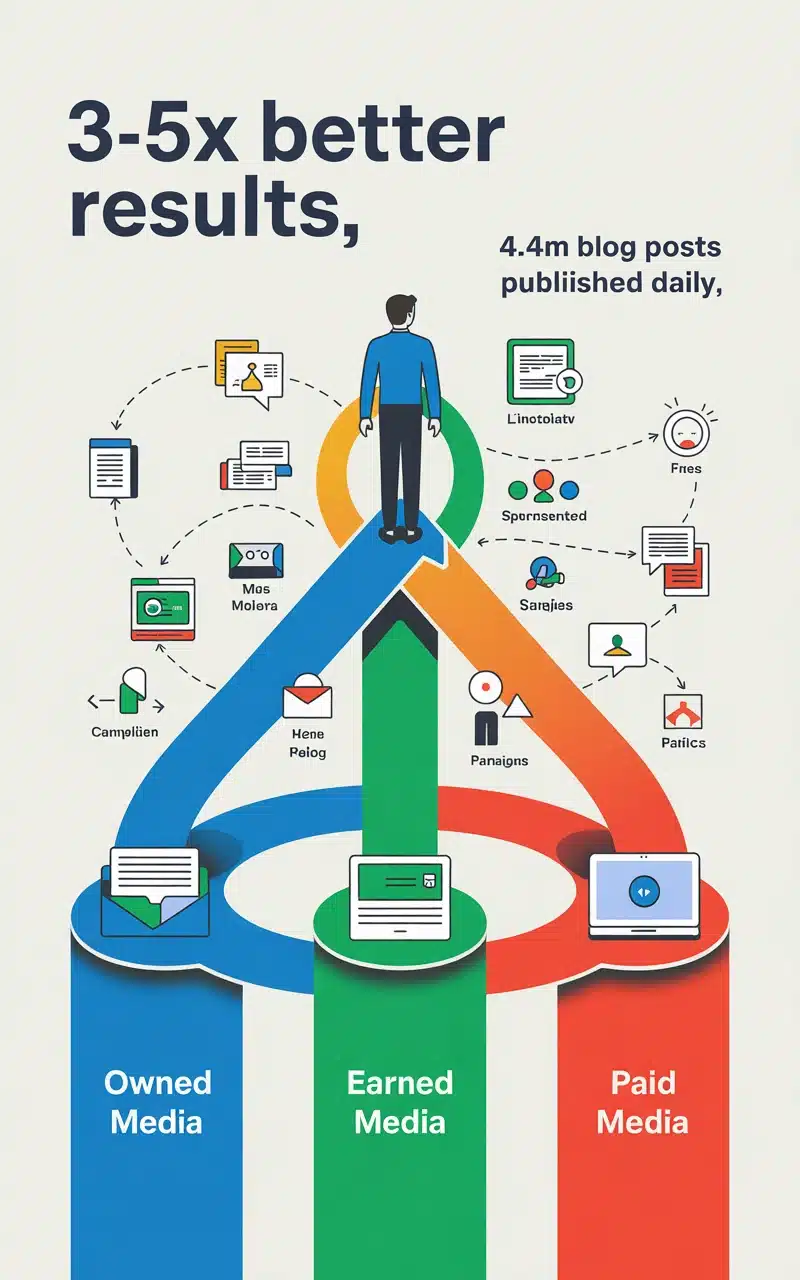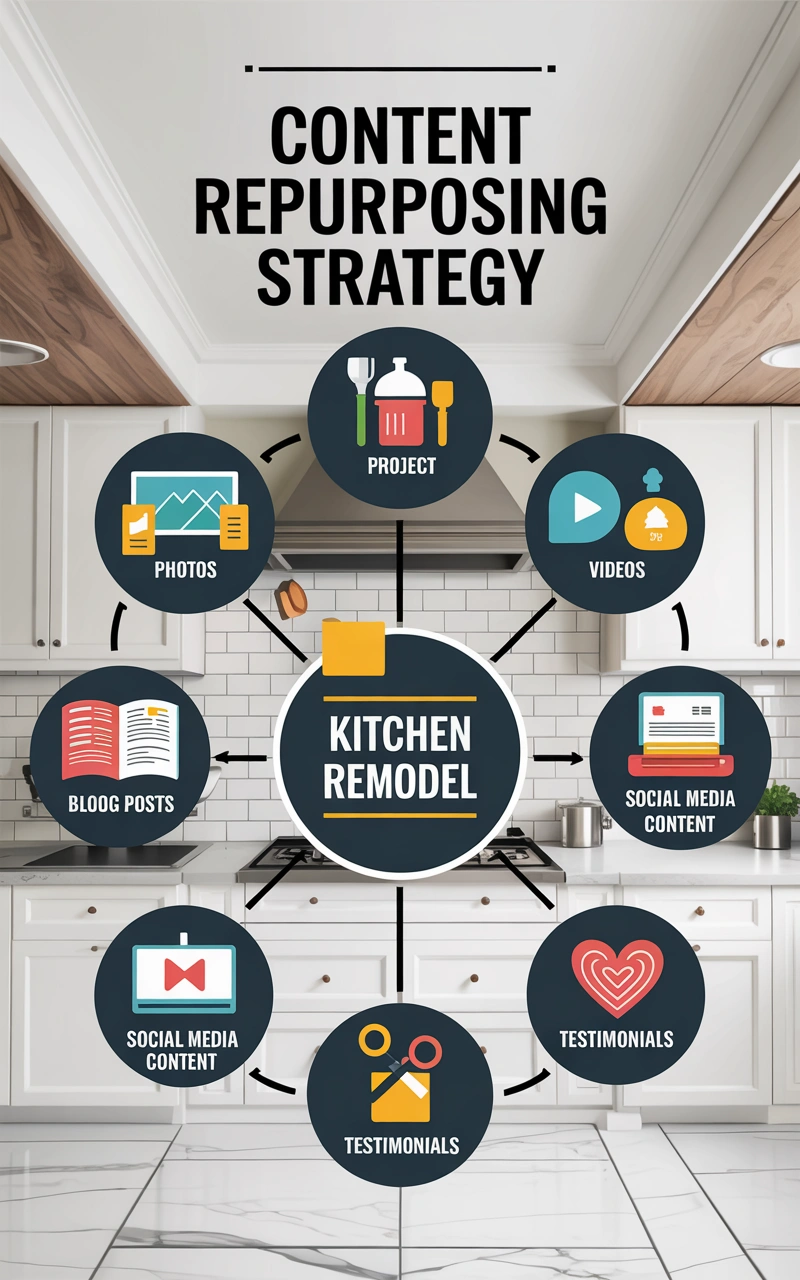
Stop Chasing Quick Wins: How Smart Businesses Build Domain Authority That Lasts
You publish content consistently. You distribute it across multiple platforms. You wait for your website’s authority to grow.
Three months later, you’re staring at numbers that barely moved.
Sound familiar?
Here’s what most business owners don’t realize: domain authority improvement content marketing works on a timeline that has nothing to do with your quarterly revenue goals. The companies seeing real long-term SEO benefits from content distribution understand something crucial—meaningful authority growth happens in 6 to 18-month cycles, not 30-day sprints.
This isn’t about patience for patience’s sake. This is about measuring the right signals at the right time to know your content strategy is working before your competitors catch up.
What Domain Authority Actually Measures (And Why It Matters)
Domain authority represents Google’s assessment of your website’s trustworthiness and expertise within your industry. Think of it as your digital reputation score—one that determines whether your content appears on page one or page ten of search results.
When you distribute content strategically, you’re not just getting your message out there. You’re building a web of trust signals that tell search engines your website deserves attention. Every mention on a credible news site, every guest post on an industry publication, and every podcast appearance creates a vote of confidence in your brand’s expertise.
But here’s the catch: these trust signals don’t translate into authority overnight.
Google evaluates websites like a careful investor evaluating a startup. They want to see consistent performance over time, not just a few flashy quarters. This means your content distribution efforts need sustained measurement across multiple data points, not just traditional ranking reports.
The Real Domain Authority Growth Timeline
Months 1-3: Foundation Building Phase
During your first quarter of strategic content distribution, you’re laying groundwork that won’t show up in authority scores yet. However, you can track several leading indicators:
- Referral traffic increases from news sites and industry publications
- Brand mention frequency in industry discussions
- Email subscriptions from content syndication efforts
- Social media engagement rates on distributed content
Months 4-6: Initial Momentum Signs
This is where many businesses give up because authority scores still appear stagnant. Don’t. Your content distribution efforts are beginning to compound. Watch for:
- Branded search volume increases (people searching for your company name)
- Journalist outreach inquiries for expert commentary
- Speaking opportunity invitations from industry events
- Competitor mentions of your content or strategies
Months 7-12: Measurable Authority Improvements
Now you’ll see movement in traditional authority metrics. More importantly, you’ll notice:
- Organic traffic from long-tail keywords you never targeted directly
- Higher average time spent on your website pages
- Increased conversion rates from organic search visitors
- Geographic expansion of your organic traffic sources
Beyond Year One: Compound Growth Effects
After 12 months of consistent content distribution, your authority growth accelerates. Each new piece of content performs better because your domain carries more weight. Each partnership opportunity leads to bigger partnerships.
This is when your domain authority growth timeline shifts from linear progression to exponential growth.
Smart Tracking Methods That Work
Traditional authority tracking focuses too heavily on single metrics that fluctuate without clear meaning. Smart measurement requires a dashboard approach that captures the full picture of your growing digital influence.
Referral Traffic Quality Analysis
Track not just the volume of referral traffic from news sites and industry publications, but the behavior of those visitors:
- Pages per session from high-authority referrers
- Conversion rates by traffic source
- Time spent reading your content
- Return visitor percentages from each source
Brand Awareness Correlation Studies
Monitor how your content distribution efforts correlate with brand awareness growth:
- Direct traffic increases (people typing your URL directly)
- Branded keyword search volume trends
- Social media follower growth rates
- Customer survey results about brand recognition
Citation Network Expansion
Track how often your content gets referenced or cited:
- Industry publication mentions
- Academic or research paper citations
- Competitor analysis inclusion
- Expert roundup participation rates
Geographic Traffic Diversification
Watch how your organic traffic sources expand geographically as your authority grows:
- New city/region traffic sources
- International visitor percentages
- Local search ranking improvements
- Regional industry publication coverage
Content Distribution Strategies That Move the Needle
Not all content distribution creates equal authority impact. The strategies that deliver measurable long-term SEO benefits, content distribution focus on quality relationships over quantity metrics.
Industry Publication Guest Posting
Target publications your ideal customers read, not just websites with high authority scores. A guest post on a mid-tier industry magazine that your target audience trusts carries more authority weight than a generic business blog with higher traffic.
Research publication editorial calendars. Pitch content that aligns with their upcoming themes. Build relationships with editors before you need them.
News Site Syndication Programs
Develop relationships with journalists who cover your industry. Provide expert commentary on trending topics. Share data insights that support their stories.
When news sites reference your expertise consistently, Google notices. When they link to your original research or quote your executives, your authority grows.
Strategic Partnership Content
Collaborate with complementary businesses on research studies, industry reports, or educational content series. When two trusted brands create content together, both benefit from increased authority signals.
Joint webinars, co-authored whitepapers, and shared research studies create authority-building opportunities that individual content efforts can’t match.
Speaking and Thought Leadership
Industry conference speaking opportunities create authority signals that extend far beyond the event itself. Conference websites, speaker directories, presentation archives, and attendee social media sharing all contribute to your authority profile.
Document your speaking engagements. Share presentation content across multiple platforms. Build speaking opportunities into your annual content distribution strategy.
Measuring What Others Miss
While competitors focus on basic authority metrics, smart businesses track the underlying signals that predict authority growth before it shows up in traditional scores.
Share of Voice Analysis
Monitor what percentage of industry conversations include your brand or representatives:
- Industry publication quote frequency
- Podcast guest appearance rates
- Conference speaking opportunities
- Expert roundup inclusion percentages
Content Amplification Patterns
Track how your distributed content gets shared and referenced:
- Secondary sharing rates (people sharing shares)
- Comment quality and engagement depth
- Cross-platform content performance
- Influencer engagement with your content
Partnership Network Growth
Measure the expansion of your professional network through content distribution:
- New business partnership inquiries
- Joint venture opportunity frequency
- Industry collaboration invitations
- Board or advisory position offers
Customer Journey Integration
Analyze how content distribution affects your sales process:
- Sales cycle length changes
- Customer education level at first contact
- Reference and case study opportunity increases
- Upsell and cross-sell success rates
Case Studies: Real Timelines from Real Companies
SaaS Company: 8-Month Authority Transformation
A project management software company started distributing content across industry publications in January. Their strategy included weekly guest posts, monthly research reports, and quarterly industry surveys.
Month 1-3 results: 23% increase in referral traffic, 156% growth in branded searches, zero change in authority scores.
Month 4-6 results: First-page rankings for 12 new industry keywords, 45% increase in demo requests from organic search, 67% growth in industry mention frequency.
Month 7-8 results: 34-point authority score increase, 89% organic traffic growth, invitation to speak at three major industry conferences.
Local Service Business: 14-Month Journey
A residential HVAC company began distributing educational content through local news sites, home improvement blogs, and industry publications.
Their content focused on seasonal maintenance tips, energy efficiency guides, and emergency repair advice. They targeted both homeowner publications and contractor industry sites.
Months 1-6: Steady growth in local search visibility, increased calls during content publication weeks, minimal authority score movement.
Months 7-12: Consistent page-one rankings for “HVAC repair [city name]” keywords, 156% increase in organic traffic, local news interviews about energy efficiency trends.
Months 13-14: Recognition as the area’s leading HVAC expert, partnership opportunities with real estate agents, 78% increase in average project value.
E-commerce Brand: Content to Credibility Pipeline
An outdoor gear company built authority through adventure blog guest posts, gear review site partnerships, and outdoor industry publication contributions.
Their distributed content included gear guides, safety education articles, and adventure destination features. They targeted both consumer outdoor publications and industry trade magazines.
6-month checkpoint: 234% increase in referral traffic from outdoor blogs, 45% growth in social media followers, industry publication recognition as gear expert.
12-month checkpoint: Featured expert status on major outdoor websites, product collaboration inquiries from other brands, 123% increase in organic search traffic.
18-month checkpoint: Speaking opportunities at outdoor trade shows, consultant role for industry research studies, 67% increase in average order value.
Common Mistakes That Delay Progress
Understanding where businesses typically stumble helps you avoid months of wasted effort and delayed authority growth.
Quality vs. Quantity Confusion
Many businesses distribute content widely without considering relevance or audience alignment. Publishing guest posts on 50 random websites creates less authority impact than strategic placement on five industry-leading publications.
Focus your distribution efforts on platforms where your ideal customers spend time and where industry influencers pay attention.
Impatience with Timeline Expectations
Businesses often abandon working strategies after 90 days because authority scores haven’t moved significantly. This is like expecting a tree to bear fruit the month after planting.
Set realistic 6-month and 12-month benchmarks. Measure leading indicators during the early months while waiting for authority metrics to reflect your efforts.
Content Relevance Misalignment
Generic business advice distributed across random publications doesn’t build industry authority. Your content must demonstrate specific expertise in your field.
Align every piece of distributed content with your core business expertise. Build recognition as the go-to expert for specific problems your customers face.
Partnership Opportunity Blindness
Many businesses focus solely on content placement without building relationships with publication editors, industry influencers, or complementary businesses.
Treat content distribution as relationship building, not just link acquisition. The relationships you build become ongoing sources of authority-building opportunities.
Tools and Metrics That Actually Matter
Smart measurement requires the right combination of traditional authority tracking and forward-looking indicators that predict growth before it shows up in standard reports.
Authority Tracking Beyond Traditional Scores
- Monthly organic traffic quality assessment
- Referral traffic source diversification analysis
- Brand mention sentiment tracking
- Industry publication quote frequency monitoring
Traffic Quality Assessment Methods
- Conversion rate tracking by traffic source
- Average session duration by referral site
- Page depth analysis for organic visitors
- Return visitor percentage from content distribution sources
Brand Mention Monitoring Systems
- Industry publication mentions frequency
- Social media brand discussion volume
- Podcast appearance tracking
- Conference speaking opportunity monitoring
Competitive Positioning Analysis
- Share of voice in industry discussions
- Comparative authority growth rates
- Content performance benchmarking
- Partnership opportunity comparison
Building Your Long-Term Measurement Framework
Success in domain authority improvement content marketing requires a systematic approach to measurement that tracks progress throughout the entire growth timeline.
Setting Realistic 12-Month Benchmarks
Establish specific, measurable goals for each quarter:
- Quarter 1: 25% increase in referral traffic, 50% growth in branded searches
- Quarter 2: First-page rankings for 10 target keywords, 3 industry publication mentions
- Quarter 3: 15-point authority score increase, 75% organic traffic growth
- Quarter 4: Speaking opportunity bookings, partnership inquiries, thought leadership recognition
Creating Monthly Progress Checkpoints
Develop a monthly reporting system that tracks both traditional metrics and leading indicators:
- Organic traffic growth percentage
- Referral traffic source expansion
- Brand mention frequency and sentiment
- Content distribution placement quality
- Partnership opportunity development
- Industry recognition and awards
Adjusting Strategies Based on Data Trends
Use monthly data to refine your content distribution approach:
- Double down on publication relationships that drive quality traffic
- Eliminate distribution channels that don’t align with your audience
- Adjust content topics based on engagement and sharing patterns
- Expand successful partnership models
Planning for Sustained Growth Beyond Year One
After 12 months of consistent effort, your domain authority growth timeline shifts into acceleration mode. Plan for this transition:
- Develop a speaking bureau representation
- Create a thought leadership content series
- Build industry advisory board positions
- Launch industry research initiatives
The businesses that succeed in long-term SEO benefit from content distribution and understand that authority building is a marathon, not a sprint. They measure the right signals at the right time. They maintain consistency when others give up. They build relationships while others focus solely on links.
Your domain authority growth timeline depends entirely on your commitment to strategic, measured, long-term thinking.
The question isn’t whether content distribution builds authority—it’s whether you’ll measure progress correctly during the months before everyone else notices your growth.
Are you ready to play the long game?
Grow Your Business – Get More Customers – Learn How it Works!







